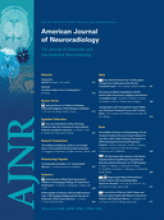Abstract
BACKGROUND AND PURPOSE: MSDE preparation is a technique for black-blood imaging. Our purpose was to evaluate the usefulness of a 3D TSE sequence with MSDE preparation in detecting brain metastases by comparing it with conventional sequences.
MATERIALS AND METHODS: Postcontrast images of 227 patients who were suspected of having brain metastasis were prospectively obtained by using 3 T1-weighted 3D sequences: a gradient-echo sequence (MPRAGE), TSE-noMSDE, and TSE-MSDE. The number of visualized blood vessels and the lesion-to-normal CNR were compared among the 3 sequences. An observer test involving 9 radiologists was performed, and their diagnostic performance by using TSE-MSDE, MPRAGE, and combined TSE-MSDE and MPRAGE was compared by means of an FOM as an index of diagnostic performance derived by the JAFROC analysis, sensitivity, FP/case, and reading time.
RESULTS: TSE-MSDE resulted in significantly better vessel suppression than the other 2 methods. TSE with and without MSDE resulted in significantly higher CNRs than MPRAGE. In the observer test, significantly higher sensitivity and FOM as well as significantly shorter reading time were achieved by TSE-MSDE compared with MPRAGE, but FP/case was significantly higher with TSE-MSDE. Combined TSE-MSDE/MPRAGE resulted in significantly higher sensitivity and FOM and similar FP/case and reading time compared with MPRAGE alone.
CONCLUSIONS: With blood vessel suppression and increased CNR, TSE-MSDE improves radiologists' performances in detecting brain metastases compared with MPRAGE, but it may increase FP results. Combined with MPRAGE, TSE-MSDE achieves high diagnostic performance while maintaining a low FP rate.
Abbreviations
- ANOVA
- analysis of variance
- CNR
- contrast-to-noise ratio
- FA
- flip angle
- FOM
- figure of merit
- FP
- false-positive
- FP/case
- false-positive results per case
- G
- gradient
- GRE
- gradient-recalled echo
- JAFROC
- Jackknife Free-Response Receiver Operating Characteristic
- LCD
- liquid crystal display
- LSMeans
- least square means
- MPRAGE
- magnetization-prepared rapid acquisition of gradient echo
- MSDE
- motion-sensitized driven-equilibrium
- NS
- not significant
- RF
- radio-frequency
- TSE
- turbo spin-echo
- TSE-MSDE
- TSE with MSDE preparation
- TSE-noMSDE
- TSE without MSDE preparation
- VENC
- velocity-encoding
- Copyright © American Society of Neuroradiology












